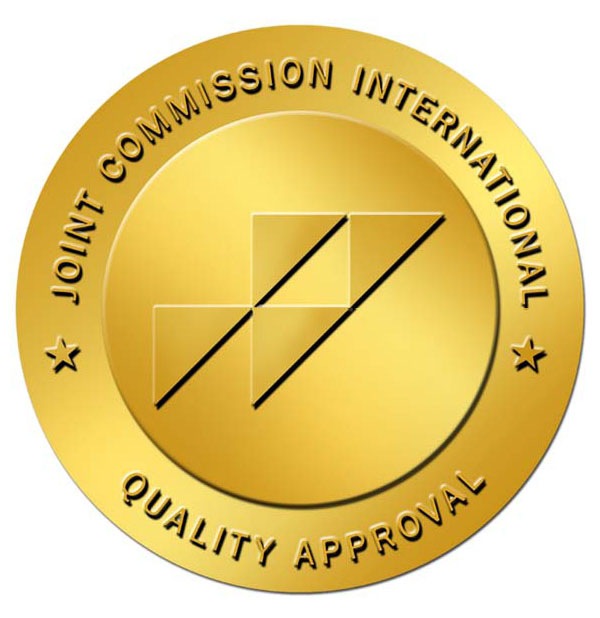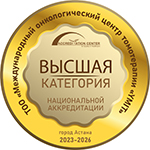«Rules of patients attendance in the center»
1.Admission rules:
1.1. Working hours of the Center are from 08:00a.m. till 08:00p.m., lunch break from 01:00a.m. till 02:00p.m. (Monday-Friday), non-working days: Saturday, Sunday.
1.2. When entering the Center, put on shoe covers or the second pair of shoes, take off your outer clothing and leave it in the cloakroom, leave valuables at home.
1.3. Treat your hands with a skin antiseptic. In the future, do it at each visit to the department.
1.4. Provide information and documents according to the list required to receive radiation therapy (Appendix No 1).
1.5. The patient treatment schedule can be changed depending on the equipment health. Information about changes in the treatment schedule will be provided in advance.
1.6. Leave mobile phones of the patient and the accompanying person at the reception.
1.7. The legal representative of the family is jointly and severally responsible for the safety of the patient/child while in the Center. The representative should not leave the patient/child unaccompanied on the territory of the center.
1.8. Taking of video by visitors in the Center is prohibited.
1.9. Taking of photo is allowed only with the consent of the Center administration.
1.10. Smoking and drinking alcohol is prohibited on the territory of the Center.
1.11. Patient first goes to the registry, after registration the patient is sent to the Radiation Oncology Department. Outpatients are referred for consultation to specialists.
2. Radiation Oncology Department.
2.1. Only one accompanying person is allowed to the Radiation Oncology Department.
2.2. In Radiation Oncology Department the patient appeals to the nurse who makes the patient identification, preparation of documents and sends him to a radiation oncologist for an appointment.
2.3. After being examined by a radiation oncologist, the patient is sent for a CT-simulation procedure.
2.4. Before the laboratory operator comes, the patient stays in the waiting room.
2.5. Lunch break with doctors on a rolling schedule.
2.5. Doctors have stagger lunch hours.
3. CT-simulation procedure.
3.1. CT-simulation takes place in the computed tomography room.
3.2. To prepare for the CT-simulation procedure, there is an individual changing room for each patient.
3.3. The patient enters the CT-simulation area through the changing room, where he changes into a disposable gown.
3.4. The laboratory operator asks the patient to go to the CT bunker for the CT simulation procedure.
3.5. Futher, the patient undergoes CT-simulation by a team of doctors and laboratory operators.
3.6. The marks that were applied during the CT-simulation must be kept (not erased) until the first radiation therapy procedure and the complete end of the treatment course.
3.7. After completion of the CT-simulation procedure, the patient is examined by a nurse of the department; if necessary, the attending physician is called.
3.8. The patient is provided with the contact details of the doctor, the phone number of the reception, and he is allowed to go home for the period of dosimetric planning of treatment.
4. Dosimetric planning.
4.1 Dosimetric planning is carried out by medical physicists.
4.2. The time of dosimetric planning of treatment can be different, from 2 to 7 working days.
4.3 The patient is being monitored by the attending physician online. If the condition worsens, patient informs the attending physician, who decides on changing the management plan.
4.5. If it is impossible to call the doctor, the patient reports the data to the registry office.
4.6. The registrar fills out the oral information transfer form and transfers it to the doctor in accordance with the rules for the transfer of oral information.
4.7. The medical physicist informs the attending physician about the readiness of the dosimetric treatment plan. The doctor approves the plan according to which the senior laboratory operator plans the time of radiation therapy session.
4.8. After that, the information is transferred to the registry to invite the patient to the 1st radiation therapy session.
5. Radiation therapy session.
5.1. The patient comes for the radiation therapy session 15-20 minutes before the appointed time.
5.2. Patients receiving radiation therapy to the pelvic area come for treatment 40-45 minutes before the procedure starts (to prepare the bladder for treatment/water regime).
5.3. The patient first comes to the registration desk and receives an access card to the radiation oncology department.
5.4. To receive a radiation therapy procedure, the patient shows an identification bracelet or badge to the center staff and is sent to the radiation oncology department.
5.5. At the nursing station, the nurse conducts an examination and calls for the attending physician for a repeated examination, who confirms the admission to the radiation therapy session.
5.6. The nurse informs the laboratory operator of the patient's readiness.
5.7. The laboratory operator asks the patient to go to the patient preparation room (changing room) and leads the tomotherapy bunker.
5.8. In the bunker, the laboratory operator places the patient on the therapy table and fixes the patient.
5.9. The attending physician, in the presence of a medical physicist and laboratory operators, conducts a time-out procedure, thereby confirming admission to the radiation therapy session.
5.10. A radiation therapy session is carried out according to the doctor's treatment plan and the developed rules for laboratory operators.
5.11. The patient's condition is monitored online through video surveillance cameras.
5.12. During treatment, the patient maintains complete immobility of the whole body in order to avoid deviation from the beam direction.
5.13. The duration of a session lasts from 10 to 20 minutes.
5.14. After the session is completed, the laboratory operator accompanies the patient to the nursing station, where the nurse assesses the general condition of the patient, if necessary calls for the attending physician.
5.15. If the patient is in a satisfactory condition, he is allowed to go home with the appointment of the date and time of the next radiation therapy session.
5.16. The patient receives a full treatment course according to the developed treatment plan.
5.17. When signs of deterioration in the patient's condition appear, the attending physician may change the treatment tactics.
5.18. After the full treatment course is completed, the patient is discharged with detailed recommendations for further follow-up of the local oncologist at the place of residence.
Patient is obliged to:
1) show respect and tact in communication with the Center staff;
2) comply with the Rules of attendance in the Center;
3) take care of the Center property;
4) provide the doctor with all the information necessary to receive radiation therapy;
5) promptly inform medical workers about changes in health status during treatment, as well as in cases of diseases that pose a danger to others, or suspicion of them;
6) comply with medical prescriptions during treatment at the Center, as well as doctor's recommendations after discharge;
7) maintain cleanliness in the premises, public areas;
8) not to commit actions violating the rights of other patients.
If patients are dissatisfied with diagnostics, treatment, service, you can appeal for the support:
Our contacts:
Head of the Department: Zhanat Shurenovna Nurazkhanovna 8 701 527 16 87
Manager of the Department: Namazova Aziza 8 701 407 52 67
Extension telephone: 10-06
Web-site: ТОМО.KZ
You can refer to the 2GIS.KZ site specifying the center coordinates.
Ikomek 109 of Astana akimat, with a single contact center for requests from residents of the city, working 24/7.







 public offer
public offer










